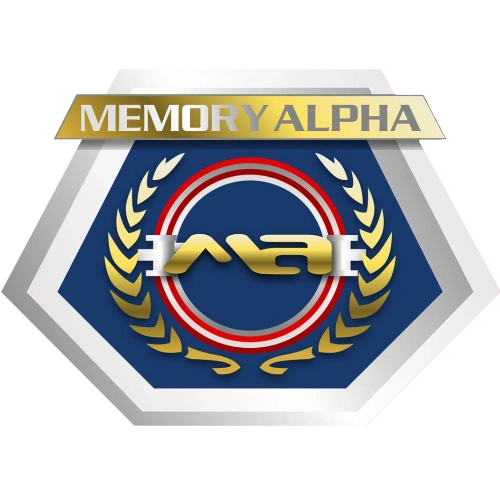|
Ten artykuł jest właśnie poddawany intensywnej rozbudowie. Poniżej znajduje się treść medalowego artykułu Anglojęzycznej Wersji Memory Alpha. Jeśli chcesz wspierać rozwój Polskiej Wersji Memory Alpha pomóż przetłumaczyć go na język polski! Zobacz też inne tłumaczone strony oraz Pomoc dla tłumaczy. |
- To jest jedynie zalążek artykułu. Pomóż Memory Alpha rozszerzając go.
"Photon torpedo: isn't that the universal greeting when communications are down?"
"I think it's the universal greeting when you don't like someone."
Torpeda fotnowa: nie jest uniwersalnym powitaniem, kiedy nie działa komunikacja?"
"Myślę, że to uniwersalne powitanie, gdy kogoś nie lubisz."
U.S.S. Enterprise, NCC-1701 wystrzeliła torpedy fotnowe
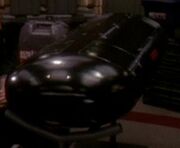
Standard model Starfleet torpedy fotnowej
Torpedy fotnowe były zdolna do warp taktyczna materia/antymateria broń powszechnie rozmieszczane na statkach kosmicznych i bazach kosmicznych przez różne organizacje. "Fotony" skrót od torped fotonowych, były również nazywane Pu'DaH dak cha w języku Klingońskim. (TNG: The Arsenal of Freedom, itd., ENT: Sleeping Dogs)
Historia

Klingoński D5 z 22 wieku wystrzelił torpedy fotonowe
Klingoni rozpoczęli używanie torped fotonowych w co najmniej połowie 22 wieku. Używali je na pokładzie statków zwiadowczych klasy Raptor, krążowników klasy D5, oraz Bird of Prey. Dla porównania, w tym samym czasie Starfleet Ziemi nadal używała torpedy podprzestrzenne, chociaż wkrótce zmodernizowane do fotoniczna torpeda, prekursor do torped fotonowych. (ENT: Fight or Flight, Sleeping Dogs, Judgment, The Expanse, Borderland)

Wyrzutnie torped fotonowych Starfleet w 2233
Okręty Starfleet używane przez Zjednoczoną Federację Planet, zaczęła używać torpedy fotonowa od co najmniej 2233 roku. (Star Trek)
24 wiek widział wdrożenie udoskonalonego typ uzbrojenia w 2371 roku: torped kwantowych. Niemniej jednak, torpedy fotonowe nadal były wykorzystywane wraz z nowymi torpedami kwantowymi, przez takie statki jak U.S.S. Enterprise, NCC-1701-E. (DS9: Defiant, Star Trek: Nemesis)
Występowanie
Lokalizacja astrometryczna : kurs z Ziemi do Deneb system, Alpha Kwadrant
Pierwszy kontakt : istota zwana Q, Q Kontinuum
2364 SD 41153.70 - 41153.80. Podczas lotu U.S.S. Enterprise, NCC-1701-D do planety Deneb IV doszło do pierwszego kontaktu załogi statku z istotą zwaną Q. Domaga się powrotu do ich własnego systemu i oskarża ludzkość o barbarzyństwo. Zniknął, aby poczynić działania do testu ludzkości.
Kapitan Picard po wysłuchaniu opinii oficerów mostka, podają decyzję na oddzielenie sekcji spodka umożliwiając jej ucieczkę, a sekcja napędowa miała stawić czoła wrogowi. Przed odłączeniem sekcji, zostało wstrzelone 8 torped fotonowych, które zostały zdetonowane wystarczająco blisko wroga, aby oślepić go w chwili rozdzielenia. Po detonacji wszystkich torped sekcja napędowa zatrzymała się. Wróg miał dotrzeć do statku w ciągu kilku minut. Kapitan ogłosił bezwarunkową kapitulację. (TNG: Encounter at Farpoint)
Przegląd
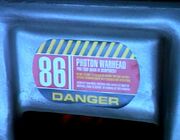
Etykieta ostrzegawcza na głowicy fotonowej
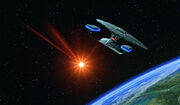
Standard torpeda fotonowa w przestrzeni
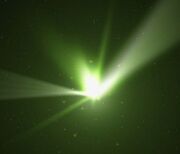
Torpeda fotonowa klasy 10 uzbrojona w nanosondy Borg
Komponenty torped fotonowych Federacji znajdowały się wewnątrz wydłużonej eliptycznej obudowy, znanej również jako tuba fotonowa. Broń była uzbrojona w głowicę fotonową. Głowica miała komorę detonacyjną wypełnioną antymaterią. Po detonacji torpeda stworzyła eksplozję materia-antymateria i wylew promieniowania jonowego. (Star Trek II: Wrath of Khan, Star Trek III: The Search for Spock, DS9: Tribunal, VOY: Good Shepherd, TNG: The Loss, New Ground)
W 2367, zasięg torped fotonowych Federacji był nieznacznie poniżej 300 000 km. (TNG: The Wounded) Kiedy startuje, torpedy fotonowe Federacji wydala gaz plazmowy do tuby torpedy. (VOY: Future's End, Part II) Torpeda fotonowa Federacji ma detonator podprzestrzenny. Może zostać aktywowany zdalnie już wystrzelonej torpedy. Detonator niszczy torpedę przed uderzeniem. (TNG: Genesis)
W 2368, wydajność głowicy torpedy fotnowej Federacji ma co najmniej 16 programowanych poziomów. Eksplozja wystarczająco potężna, aby rozproszyć falę solitonową może być stworzona z pięciu torped ustawionych na poziom 16. (TNG: New Ground) Zgodnie z wypowiedzią Kyrian kuratorem Quarren, torpeda fotonowa z wydajnością 25 isoton może zniszczyć całe miasto w ciągu sekund. (VOY: Living Witness)
Biorąc pod uwagę, że wiele innych informacji o U.S.S. Voyager były niepoprawne VOY: Living Witness, a te informacje stwierdzone o torpedzie że były nieaktywne przez wieki, dokładność jest wypowiedzi jest wątpliwa.
Kiedy wystrzelona przez statek kosmiczny klasy Galaxy bez osłon w celu w bliskim zasięgi, pojedyncza detonacja fotonu ma wysokie prawdopodobieństwo zniszczenia statku, który ją wystrzelił. W 2365, nie osłoniona U.S.S. Lantree, NCC-1837 została zniszczona jedną torpedą fotonową. U.S.S. Enterprise, NCC-1701-D znajdowała się w odległości 40 km. (TNG: Q Who, Unnatural Selection)
Widziano torpedy torpedowe niszczące statki kosmiczne z pojedynczym trafieniem w DS9: The Way of the Warrior.
W 2367, jeśli torpeda fotnowa została wystrzelona przez statek kosmiczny klasy Galaxy z osłonami, z bliskiej odległości, eksplozja torpedy może uszkodzić strzelający statek. Kiedy siła osłon została zwiększona o 300%, statek nie został uszkodzony, kiedy torpeda w pełnym rozproszeniu przez maksymalnej wydajności została zdetonowane w bliskiej odległości. (TNG: The Nth Degree)
Torpedy używane przez Federację w 2365 mogą przeniknąć poprzez powierzchnię planety nienaruszona. W 2367, osłony torpedy mogą chronić przez kilka sekund, podczas których torpeda może wchłonąć w słońce i wniknąć w rdzeń gwiazdy. Siniki lotu torpedy używają reactants posiadane na pokładzie dla energii. Torpedy fotonowe Klingonów i Federacji mają częstotliwości, podobnej do modulacji częstotliwości deflektor osłon jego celu, mierzone w megahercach. Gdy obydwa były dopasowane torpedy mogły przeniknąć osłony statku celu. (TNG: Pen Pals, Half a Life, Star Trek: Generations, VOY: Equinox, Part II)
Nie jest jasne, czy częstotliwość torpedy była właściwie modulacją częstotliwości osłon torpedy. A line by Geordi La Forge w skrypcie TNG: Half a Life potwierdził torpedy używały silniki podtrzymujące napęd. Ten dialog został skrócony dla wyświetlonego odcinku. [1]
Antymateria ładunki były typem systemu broni niskiej wydajności, który może zostać upgraded do torped fotonowych. W 2365, Geordi La Forge zwiększył rozmiar ładunków na statku Pakled Mondor i zmienił broń Pakled w torpedy fotonowe. (TNG: Samaritan Snare)
W celu oszukania statków wroga można stworzyć fałszywe odczyty sensorów za pomocą thoron pola i duranium cienie. (DS9: Emissary, The Way of the Warrior)
W 2370, Quark zaaranżował sprzedaż dwustu Pygorian torped fotonowych, wśród innych przedmiotów, dla Maquis poprzez ich przemytnika broni Sakonna. (DS9: The Maquis, Part I, The Maquis, Part II)
Typ torped fotonowych Federacji
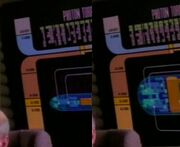
Schematy torped fotonowych używane w 2367
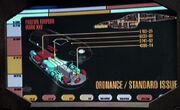
Schemat torpedy Mark XXV
Kilka małych cylindrycznych torped ułożone w zatoce torpedowej alternatywnej alternatywna rzeczywistość
Statki kosmiczne klasy Constitution przewożą zapas torped Mark VI z terminium obudową w 2285, oraz torpedy fotonowe Mark VII w 2293. Przynajmniej torpedy Mark VII nie mogą być zaprogramowane, aby wystrzelić siebie bez wyrzutni torped. (Star Trek II: Gniew Khana, Star Trek III: W poszukiwaniu Spocka, Star Trek VI: Nieodkryta Kraina)
W 2370, statki klasy Galaxy otrzymały modernizację broni, która zwiększyła wydajność eksplozyjną torped fotonowych o 11%. Później tego roku, głowice fotonowe używane na Deep Space 9 były oznaczone jalp "Pho-torp Mark IV komponenty". (TNG: Genesis, DS9: Tribunal)
Torpeda Mark IV nie została nigdy nie pokazana na ekranie, ale została przedstawiona w Star Trek Encyclopedia i Star Trek: The Magazine ma rozmiar i kształt innych obudowy torpedy widziane na ekranie.
U.S.S. Voyager, NCC-74656 została wyposażona w torpedy fotonowe typ 6. Nie były używane przed startem U.S.S. Voyager w 2371. Niektóre z tych torped ma wydajność 25 izoton. Głowica klasa 6 w tym typie torpedy ma wydajność wybuchową 200 izoton. Torpedy te posiadają efektywny zasięgu około 8 mln km. Torpedy klasa 6 nie były w stanie stworzyć dziury w podprzestrzeni. (VOY: Dreadnought, Scorpion, Part II, Living Witness, Human Error, The Voyager Conspiracy)
U.S.S. Voyager, NCC-74656 przewoziła również torpedy fotonowe klasa 9 i klasa 10. Qatai uważał, że ładunki wybuchowe jednej torpedy klasa 9 mogła zniszczyć gigantyczny "telepatyczny pitcher plant" bioplazmiczny organizm, jeśli zostałaby zdetonowana głęboko w jego przewodzie kablowym. (VOY: Bliss) Torpeda klasa 10 może być uzbrojona w nawet bardziej potężne głowicy wysokiej wydajności. (VOY: Scorpion, Part II, In the Flesh)
Komputer ekran pokazujący wnętrze torpedy klasa 9 zostały użyte przez oszustów w 2376, zidentyfikowała jako standard wydanie torped U.S.S. Voyager, sklasyfikowane jako Mark XXV. (VOY: Bliss, Live Fast and Prosper)
Grafika przedstawiająca wnętrze Mark XXV po raz pierwszy pojawiła się w Star Trek: Deep Space Nine Technical Manual, skąd pochodzi również nazwa. W VOY: Bliss grafika znaleziono w manifeście broni U.S.S. Voyager jako torpeda klasa 9, bez nazwy Mark XXV. W obydwu manifests diagram fazer działa, również oryginalnie stworzona dla Star Trek: Deep Space Nine Technical Manual jaki broń U.S.S. Defiant, NX-74205, także pojawiła się jako broń U.S.S. Voyager. To również sugeruje grafikę, gdzie używa tylko jako ogólne schematy broni, ponieważ przypuszczalnie U.S.S. Voyager nie posiadała fazer dział.
W 2258, alternatywna rzeczywistość z alternatywna rzeczywistość przewoziła mniejsze cylindryczne torpedy fotonowe. Do wyrzutni można załadować równocześnie. (Star Trek 11)
Rok później, U.S.S. Enterprise została doposażona w dodatkowe większe rury torped wzłuż drugorzędnego kadłuba dla prototypowych zaawansowanych torped dalekiego zasięgu. Torpedy te zostały zaprojektowane niewykrywalne dla sensorów. (Star Trek 12)
Other uses and modifications
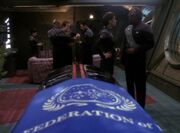
Used as a casket, draped with flag of the Federation
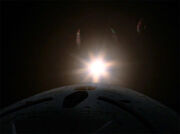
A photon torpedo used as a "warp flare"

A Mark V torpedo behind a smiling Data
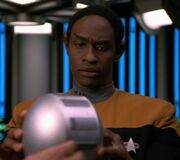
Tuvok with a gravimetric charge
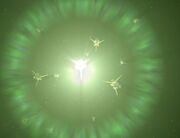
A high-yield warhead explosion, scattering Borg nanoprobes
- It has become something of a Starfleet tradition to place dead crewmembers inside an empty torpedo casing, and often such torpedoes are launched into space. The tradition is similar to the ancient Earth tradition of the burial at sea.
- Spock, Enrique Muñiz, Captain Lisa Cusak, and Jadzia Dax were placed in empty torpedo casings after their deaths. Spock's body was launched towards the rapidly-forming Genesis Planet. It is unknown, however, as to whether or not Cusak's or Jadzia Dax's bodies were launched into space, or if they were returned home for more traditional ceremonies. (Star Trek II: Gniew Khana; DS9: „The Ship”, „The Sound of Her Voice”, „Tears of the Prophets”) Non-Starfleet personnel have also received this type of burial. Dr. Ira Graves' body was beamed into space in a tube with a transparent window to display his face. Lieutenant John Kelly's corpse, recovered from a graviton ellipse in 2376, was launched into space in a standard torpedo tube. (TNG: „The Schizoid Man”; VOY: „One Small Step”)
- In 2259 in the alternate reality, Szablon:Alt retrofitted 72 advanced long-range torpedoes by removing a fuel container to make room inside the torpedo casing to smuggle his old crew from the Szablon:SS who were stored inside cryotubes. (12)
- In 2293, Spock and McCoy modified a photon torpedo to follow the trail of ionized gas from Chang's Bird-of-Prey at Uhura's suggestion. This exposed the cloaked Bird-of-Prey and allowed its destruction by the USS Enterprise-A and the USS Excelsior. (Star Trek VI: Nieodkryta Kraina)
- A volley of Romulan photon torpedoes was credited for catalyzing a Kerr loop out of superstring material, that resulted in a symmetrical temporal rift, a wormhole without a definable center or event horizon, between 2344 and 2366. (TNG: „Yesterday's Enterprise”)
- In 2368, Data used a "high-energy burst level 6" yield setting on the photon torpedo warheads to expose tachyon signatures with inertial displacement as a convoy of cloaked Romulan Warbirds. This setting presumably did not damage the Warbirds. (TNG: „Redemption”)
- Torpedoes could also be deployed like mines. When released as mines, the torpedoes did not glow in any way. Armed torpedoes could be transported via the transporter to a specific location to detonate. (VOY: „Year of Hell”, „Dark Frontier”, „Child's Play”)
- In 2364 Federation photon torpedoes had a display blast setting. A spread of torpedoes at this setting were detonated a kilometer from the surface of Ligon II as a warning burst to demonstrate the power of a Szablon:Class starship. (TNG: „Code of Honor”)
- Photon torpedoes could be used for illumination. Torpedoes were used, by manually configuring them to emit luminous bursts with the initial dispersal of 6.9 kilometers, to illuminate dark matter particles in the Mar Oscura Nebula. (TNG: „In Theory”) A torpedo was similarly modified to be a "warp flare", by reconfiguring it to emit a sustained polyluminous burst, for illumination in a region of space with a heavy concentration of theta radiation. (VOY: „Night”)
- Doctor Timicin from Kaelon II made several modifications to the guidance system of Federation photon torpedoes that would enable him to implement his theory of helium fusion enhancement and possibly revitalize the Kaelon sun. (TNG: „Half a Life”)
- Modifications to a photon torpedo could be made, so that a detonation inside a supernova remnant, like the MacPherson Nebula or a pulsar, like Dikon Alpha, would create a reaction that would artificially produce vertion particles. (TNG: „Emergence”)
- A Federation class 8 probe used the same casing as a photon torpedo. It could be launched from a stationary platform at warp 9 and could travel at that velocity. (TNG: „Pen Pals”, „The Emissary”)
- Doctor Tolian Soran had several Starfleet torpedo casings labeled as Mark V and Mark IIB torpedoes, and smaller tube components labeled with Mark IIB, Mark IV, Mark VI, among his collection of solar probes in his secret torpedo bay aboard the Amargosa observatory in 2371. He modified one of the torpedoes to carry a trilithium weapon. (Star Trek Pokolenia)
- When outfitted with a phase discriminator, the phase differential of the explosion of a photon torpedo could re-phased to be delivered into the variance of a different time continuum. (TNG: „Time's Arrow, Part II”)
- When outfitted with a gravimetric charge, a photon torpedo could be turned into a gravimetric torpedo. Depending on the yield of the charge, several results could hypothetically be achieved, such as destroying a small planet, detonating a protostar to form a wormhole, or annihilating omega molecules. (VOY: „The Omega Directive”)
- In 2374 and 2375 a number of standard and class-10 photon torpedoes of the USS Voyager were modified to be bio-molecular warheads. (VOY: „Scorpion, Part II”, „In the Flesh”)
- The catalytic agent used to recombine nucleonic particles in the atmosphere of a planet could be encased in photon torpedoes. A detonation of multiple torpedoes in the troposphere could be used to deliver the agents globally in the concussive forces of the blasts to create the isolytic reaction. In 2378, USS Voyager neutralized the antimatter radiation in Uxal's atmosphere using this method. (VOY: „Friendship One”)
- When a ship without propulsion was on a decaying orbit around a planet, the shock wave of multiple photon torpedoes detonated at once less than a kilometer away could be used to gain altitude temporarily. Such a technique was used in 2151 to rescue the Szablon:IKS from being crushed by the atmospheric pressure of a gas giant. (ENT: „Sleeping Dogs”)
Zobacz też
- Wzór rozproszenia
- Foton
- Foton impuls
- Foton ładunek
- Fotoniczna fala uderzeniowa
- Torpeda
- Tuba torpedy
- Wyrzutnia torpedo
- Zatoka torped
Informacje ogólne
Utwierdzenie torped fotonowych
Oryginalna Seria efekty specjalne dla zarówno przybliżone fazer łaadunków i torped fotonowych
Photon torpedoes were introduced fairly late into the first season of Star Trek: The Original Series. They made their on-screen debut in the 19th episode of the series, Arena. Before that, when the USS Enterprise fired shots that looked like globular bursts, they were identified in dialogue as proximity blasts from the phasers, as in Balance of Terror. In fact, the early writer's guide, The Star Trek Guide, made no mention of the ship having photon torpedo armaments. [2] The sound of the proximity blasts (and subsequently the photon torpedoes) firing was that of the disintegration ray from the 1953 film The War of the Worlds.
The Szablon:Y reference book The Making of Star Trek (page 194), gave this early description of the photon torpedo: "...photon torpedoes, which are energy pods of matter and anti-matter contained and held temporarily separated in a magno-photon force field. These can be used as torpedoes or depth charges, and can be set with electrochemical, proximity, and a variety of other fuses. Photon torpedoes can be fired directly at a target, laid out as a minefield, or scattered in an attacker's path as depth charges." However, the earlier Szablon:Y episode Obsession seemed to contradict the whole notion that there was antimatter in these photon torpedoes. In the story, the Enterprise crew attempt to destroy the Dikironium cloud creature by exploding photon torpedoes inside it, when that had no effect, they turn to the most powerful weapon available at that time: an ounce of antimatter to produce a matter-antimatter blast to destroy the creature.

Kapitan Spock foton torpeda trumna w Star Trek II: The Wrath of Khan
The idea that the photon torpedoes themselves had physical missile-like casing was never confirmed on screen during The Original Series. The idea of distinct "launchers" (or "tubes") for the torpedoes was first introduced in the second season episode, The Changeling, as "torpedo number 2" was fired instead of just a "torpedo bank being discharged". Even as late as Star Trek I, Andrew Probert did not envision the photon torpedo to be a capsule, as he says in his 2005 Trekplace interview: "I envisioned them as what we saw during the TV era, they were glowing globs of plasma or some sort of energy. They weren't giant capsules. I envision them as big, glowy, dangerous blobs of... scariness." [3]
Photon torpedoes were definitely weapons with physical missile casings by the time of the Szablon:Y feature film Star Trek II: Gniew Khana. Furthermore, the special effect of a torpedo launched with a warhead and one launched as a coffin was completely different in the film. The first on-screen connection between photon torpedoes and antimatter came in Szablon:Y, in the second season episode Samaritan Snare of Star Trek: The Next Generation and it was not established until Szablon:Y, in the fourth season episode Half a Life, that photon torpedoes had in fact deflector shields of their own.
While photon torpedoes made their first appearance in "Arena", set in the year 2267, the earliest on-screen use of photon torpedoes by a Starfleet vessel was depicted in the Szablon:Y film, Star Trek 11, when the USS Kelvin defended itself from torpedoes fired by the Narada with phasers and a rapid-fire barrage of photon torpedoes, in a scene set in the year 2233. KelvinSzablon:'s blue bolts were not identified in the dialogue of the film, but were identified in the script as photons. [4] It was also established in the Szablon:Y episode Sleeping Dogs of Star Trek: Enterprise that the photon torpedo was in fact not an original Federation invention, but had in fact been used before by such races as the Klingons as far back as the 22nd century.
Technical Manuals
Star Trek: The Next Generation Technical Manual
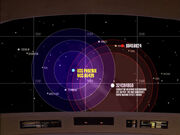
Zasięg torped fotonowych U.S.S. Phoenix, zidentyfikowano poniżej 300 000 km, opierając się na dialogu
- Starfleet began developing two types of photon torpedoes starting in 2215, with the primary difficulty being the design of the warhead. The first type had the deuterium and antideuterium reactants driven together like in an implosion design nuclear weapon. This torpedo had a maximum range of 750,000 kilometers, as this was the stability limit of the containment field design. It had a low rate of annihilation, and was adequate as a defensive weapon only. The second type, which became operational in 2271 had the reactants mixed together in thousands of small magnetic packets. This increased the rate of annihilation. This type had an effective tactical range from fifteen kilometers to 3.5 million kilometers. (pg. 128, 130) These range figures are however inconsistent with the range of below 300,000 kilometers established in The Wounded for a torpedo type used in 2367.
- The second type warhead was loaded with a maximum yield of only 1.5 kilograms of antideuterium. Due to the premixed reactants, the released energy per unit time is greater than in a rupture of a storage pod containing 100 cubic meters of antideuterium. The torpedo had a dry mass of 247.5 kilograms. (pg. 129, 68 referenced) By using standard physics calculations, a payload of 1.5 kilograms equals to about 64.4 megatons. The second type, at maximum yield, generates the destructive effects greater than in an antimatter pod rupture. Antimatter is stored as liquid or slush on starships. (pg. 69) Density of mere liquid antideuterium is around 160 kilograms per cubic meter. According to this comparison the high annihilation rate energy release would be comparable to the effects in a 690 gigaton explosion. For the sake of plausibility the affected blast area at these intensities might be extremely small. Visual effects on-screen would seem to confirm this. Antimatter calculator: http://edwardmuller.com/calculator.htm
- As a safety measure the matter and antimatter are kept initially completely separated in the warhead. Only after the launch they are mixed during flight in the combiner tank, while still separated from each other in magnetic packets. This mixing takes a minimum of 1.02 seconds. (pg. 128, 129) This would explain why photon torpedoes are usually launched at very slow velocities when their targets are in relatively close range. As the travel time must always be over one second for the warhead to be ready to detonate.

A sonda klasa VIII
- The propulsion system of the torpedoes is a warp sustainer engine. The engine coils of the torpedo grab and hold a hand-off field from the launcher tube's sequential field induction coils. A miniature matter/antimatter fuel cell adds power to the hand-off field. When launched in warp flight, torpedo will continue to travel at warp, when launched at sublight, torpedo will travel at a high sublight speed, but will not cross the warp threshold. (pg. 129)
- Class VIII medium-range and class IX long-range multi-mission warp probes both use a modified photon torpedo casing and a warp sustainer engine as the power plant. (pg. 117,118)
Szablon:Clear
Star Trek: Deep Space Nine Technical Manual

Wnętrze torpedy fotnowej oznaczenie XXV
Samo replikująca mina uzbrojona w głowicę fotonową
- Torpedoes will obtain a high sublight speed when launched from a stationary launch platform. They are still effective against close-in threat vessels. The fact that a class 8 probe was supposedly launched by a starbase at warp speeds in "The Emissary" might be inconsistent with the statement that photon torpedoes can't reach warp speed if launched from a stationary or a sublight platform.
- The Mark XXV torpedo was the current design as of 2375. It has a dry mass of only 186.7 kilograms. The reactant capacity has increased five percent over the previous design, leading to a slightly higher yield of 18.5 isotons. The reactants are in a cryogenic state. Effective tactical range was increased to 4.05 million kilometers. (pg. 84 and 94 referenced) This range would also be inconsistent with the eight million kilometer range figure given in Human Error of a torpedo type that had entered into service in 2371.
- The 25 isotons is the theoretical maximum yield limit for the standard photon torpedo first developed in 2268. This theoretical maximum was finally reached with the Mark IX warhead. (pg. 85) This yield level statement would contradict the 200 isoton figure from "Scorpion, Part II", not to mention the special high yield torpedo from that episode, that was supposedly even more powerful.
- The self-destruct packages aboard the USS Defiant are photon warheads. On Star Trek: Deep Space Nine, self-destruct is augmented with photon warheads scaled up 1.5 times of what is normally installed on torpedoes. The self-replicating mines had a photon warhead combiner tank as their explosive charge. (pg. 93, 94, 134)
Szablon:Clear
Star Trek: Voyager Technical Manual
- The explosive yield (of the type-6 torpedo) could be set to ten different levels. Level 1 was just a fireworks display, level 5 was the standard yield of one kilogram antimatter charge, and level 10 violated strategic arms limitation treaties.
- An Szablon:Class ship didn't carry the material to fabricate casings for these torpedoes, and needed planetary raw materials to make new ones. This statement would solve the inconsistency problem of the Voyager using over ninety torpedoes during the run of the series, while it was stated in the first season episode The Cloud that there was no way to replace the 38 torpedoes they had left at that time.
Mr. Scott's Guide to the Enterprise
- The Beltesha Missile Systems Mark VI photon torpedo replaced the Morris Magtronics Model FP-4 torpedo during the Constitution-class refit in the 2270s. The Mark VI has four magnathrust propulsion units. (pg. 82, 85) The special effect of the original series photon torpedo is considerably different from the torpedoes seen from Star Trek I onwards. This also suggests a change in the torpedo model.
While the Technical Manuals and Guides themselves are not canon, they are Memory Alpha Szablon:Ma.
External link
- List of weapons in Star Trek, artykuł na polskiej Wikipedii.
